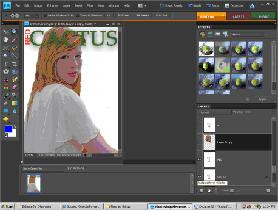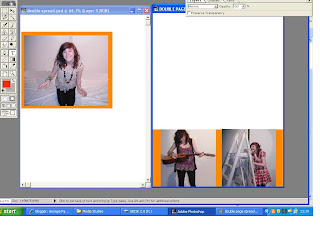
I liked the style of my orginal double spage spread as I thought it represented my genre of country music well. There I decided to keep the overall style, eg colours.
Firstly I decided that I would keep the colour of the text orange and black, as I thought the text stood out well as they are two contrasting colours. I realised after I had printed my orginal double page spread that the text was two large, (12pt) therefore I made the new text size 9pt.

I added the photos that I had taken, from my research I decided that instead of having four pictures like on my orginal one, I should have three and make them bigger. I therefore add the pictures where I thought made the page look balanced, and then rearranged the text columns around the images.

Firstly I decided that I would keep the colour of the text orange and black, as I thought the text stood out well as they are two contrasting colours. I realised after I had printed my orginal double page spread that the text was two large, (12pt) therefore I made the new text size 9pt.

I added the photos that I had taken, from my research I decided that instead of having four pictures like on my orginal one, I should have three and make them bigger. I therefore add the pictures where I thought made the page look balanced, and then rearranged the text columns around the images.

As one aspect of my text was an introduction to the story, I decided to make that it a bigger font, to attract the audience. I made it size 13pt which was considerably bigger. To ensure that I was following conventions I made the first letter of the text bigger, this would make my double page spread recognisable.

I then added the heading for my double page spread, which after hearing the feedback from my orignal double page spread I found that it should be bigger. Therefore I just decided to have her name across the top of the page in size, 128pt. I also had this font in italics as I thought it represented the genre of my magazine well. I chose to do it in red as this was the colour on my magazine that had been most used.

I knew that a convention of double page spreads is the use of quotes, this makes the page more interesting and the quotes will attract the audience to read more of the story. There I added one large quote on the largest picture of Rose Page. And then I added one before the interview as I thought if the audience read it they would want to know more about the quote. I added the final quote to help balance the page and make it seem more interesting. I also added captions on to the bottom on the two large pictures on my page, this meant I was following conventions of country music double page spreads but it also gave some background information to the pictures I had used.

The final aspects I added to my double page spread was the page number at the bottom of the page, which I repeated throughout my magazine, and then the magazine name in the right hand corner which was also repeated throughout my magazine. Each time I added these aspects to my pages I ensured that they were exactly the same colours, making my magazine constant. To do this I used the colour grabber tool on Photoshop.

I then added a text box in the last columns which contained the tour dates of my featuring artist, this meant I was following conventions. I also added it because I thought it made my page look more interesting.
I then added the background to my magazine, which I was unsure of what colour to use. After trying many colour I decided to use a light yellow as I thought that it brightened the page and made the text all stand out.

Overall I feel that my new double page spread was quite similar to my orginal one, mainly because of the style, and the tone used. The main aspects that I think improved the quality of my double page spread was the layout and the new pictures. As I think they were more appealing to the audience.

I then added the heading for my double page spread, which after hearing the feedback from my orignal double page spread I found that it should be bigger. Therefore I just decided to have her name across the top of the page in size, 128pt. I also had this font in italics as I thought it represented the genre of my magazine well. I chose to do it in red as this was the colour on my magazine that had been most used.

I knew that a convention of double page spreads is the use of quotes, this makes the page more interesting and the quotes will attract the audience to read more of the story. There I added one large quote on the largest picture of Rose Page. And then I added one before the interview as I thought if the audience read it they would want to know more about the quote. I added the final quote to help balance the page and make it seem more interesting. I also added captions on to the bottom on the two large pictures on my page, this meant I was following conventions of country music double page spreads but it also gave some background information to the pictures I had used.

The final aspects I added to my double page spread was the page number at the bottom of the page, which I repeated throughout my magazine, and then the magazine name in the right hand corner which was also repeated throughout my magazine. Each time I added these aspects to my pages I ensured that they were exactly the same colours, making my magazine constant. To do this I used the colour grabber tool on Photoshop.

I then added a text box in the last columns which contained the tour dates of my featuring artist, this meant I was following conventions. I also added it because I thought it made my page look more interesting.
I then added the background to my magazine, which I was unsure of what colour to use. After trying many colour I decided to use a light yellow as I thought that it brightened the page and made the text all stand out.

Overall I feel that my new double page spread was quite similar to my orginal one, mainly because of the style, and the tone used. The main aspects that I think improved the quality of my double page spread was the layout and the new pictures. As I think they were more appealing to the audience.





























